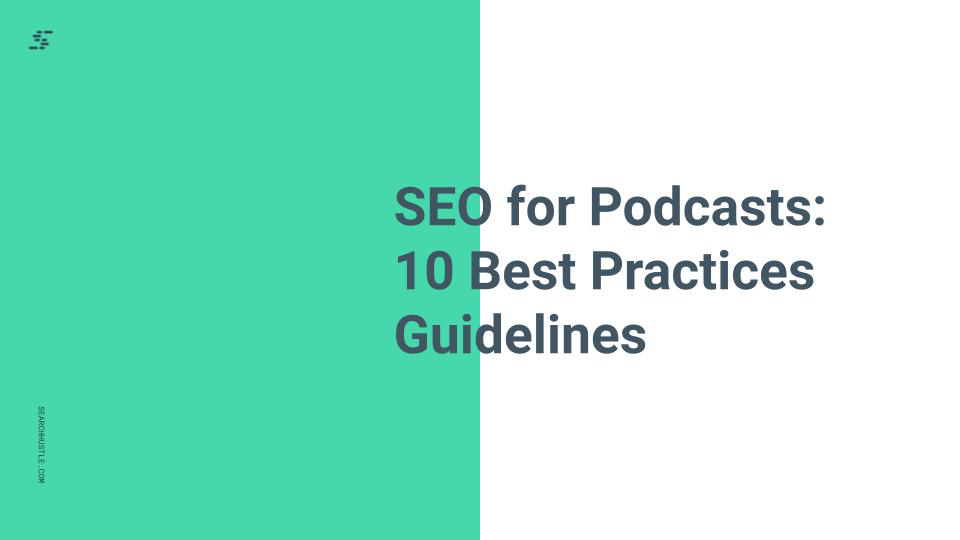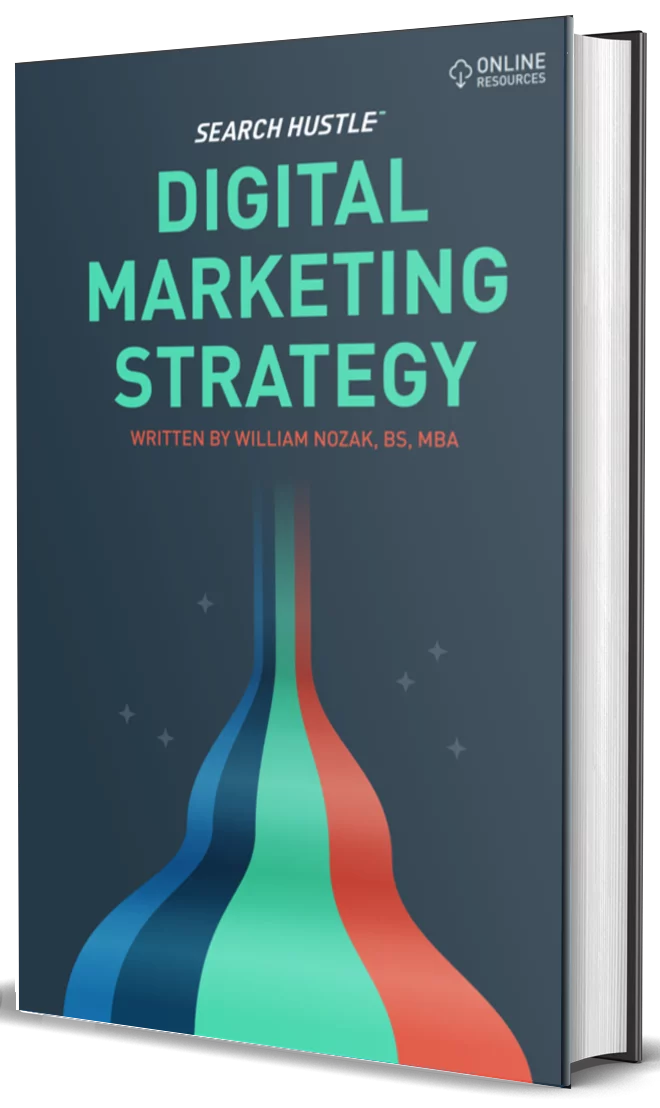SEO for Podcasts: 10 Best Practices Guidelines
Learn about ten best practices for SEO for podcasts with Search Hustle.

The second segment of this podcasting SEO post is a reminder of the best practice guidelines for podcasting. Take a quick look through, and make sure you’ve nailed each point on your episodes when you release them.
As with any content you release online, quality is key. These podcasting best practices won’t just ensure you’re delivering a consistent, high-quality podcasting production, but it will also boost your user’s experience and ensure your episodes are presented in the most professional way.
1. Subscribe Button
Subscribers are critical. This should be the most important, and most prominent CTA you have on the page. Always take a moment to remind your listeners that you would like them to subscribe. If you’re publishing podcasts where subscription buttons are used, this is a great way to retain your audience.
If you’re using YouTube, for instance, this can have an even greater impact. If your listeners subscribe, the algorithm will notice this interaction. You may find your viewership increasing as others with similar subscriptions and interests are directed towards your podcasts.
Drawing in more viewers and keeping fans informed of activity are all major benefits of using the Subscribe button. Remember this the next time you’re about to end a podcast and remind your audience that on websites such as YouTube the bell icon must also be clicked if notifications are desired.
2. Smart Placement
Always place your podcast above the fold, so your visitors don’t need to scroll down the page too far before they hit the content. If you’re using your own website to publish content, it helps to lead in with the podcast itself. At the very least, don’t bury it underneath a lot of other, extraneous content.
The more content that your viewers have to read or go through the less interested they will be in continuing. Even if they find and watch the podcast after reading through additional content, they may not be as interested or as focused, which can hurt your audience retention.
3. Summary and Key Takeaways
This makes it quick and easy for someone to see what the content is about and whether or not it is relevant. Not all visitors will be able to listen to the cast there and then. This gives them a snappy overview they can quickly digest. Make it interesting, as this content could be the deciding factor as to whether or not they return later to listen to the cast.
Key takeaways and summaries can also benefit from the use of keywords. This will make the page more searchable, and increase the likelihood of new viewers seeing it. Anything to increase traffic to your site and podcast will be a net benefit for you.
Beyond that, consider using dialog from the podcast itself. If you’re using Google, most podcasts have automatic transcripts produced now. This makes it a lot easier to draw actual words and statements from you and your guests to use as headers or one-liners to enhance your summary with.
4. Related Episodes
Never miss out on an opportunity to promote other content you’ve created. Perhaps add a couple of links to episodes in the sidebar to make it as easy as you can for them to view and play other casts. When doing this, coordinate the related episodes based on content.
For instance, if you have a guest who is an expert in a certain field, link to other podcasts which speak to that field. This can give further context, answers, or even solutions to questions asked during the other podcast. Overall giving your podcast a more professional and nuanced feel.
If you have a guest on more than once, you can also do this. Some viewers may really enjoy your interactions with a regular guest. Linking them to other podcasts where the same guest spoke can draw them even deeper into your content. Topic, guests, opinions, any way you can relate episodes together for your guests will be rewarded.
5. Timestamps
Making your timestamps clear and clickable, so they automatically link a user to a specific point in a recording. This a great way to boost the user experience of your podcast. Timestamps can be done in more than one place depending on where you’re publishing your content.
For instance, if you are using your own page, directly underneath the podcast you can put a list of timestamps. For long, in-depth conversations, these can be extremely useful for your audience to find the exact moments they want to hear again or want to hear even for the first time. Not everyone has time to sit through an entire podcast.
If you’re using a site like YouTube, remember that you can break up the status bar by topic and time spoken on it. This would be a visual aid, and you can also name each broken-up section on the status bar. This will show your audience how much you spoke about each topic in an easy-to-understand visual format.
On sites like Youtube, you can also list your own timestamps. For best results, do this in the description of the video. This will direct people to the status bar, where they will be able to see the different topics discussed, but means it isn’t required if they are on a small screen device, such as a smartphone.
6. Share Buttons
Another fundamental element of podcast SEO is to make it easy for people to share your content online with others. This can be done in a variety of ways. Some websites have built-in sharing functionality, while others you will have to do yourself.
For instance, most social media sites, such as Facebook, have a share option. This enables your viewers to share your episode via a link and thumbnail to their entire friend list. This can bring in a lot of interested viewers in one fell swoop, but there are other options.
YouTube, another major site for publishing content, has a share option. This can be used by your viewers and you to link to other sites, such as Facebook. There are options, such as a copy link, etc, which you can suggest to your audience that they should click on and share to their various social media sites.
7. Ask for an Email Address
Another good SEO tactic for your podcast is to make sure you clearly ask users for an email address. It’s usually a good idea to have a pop-up appear before the recording starts. This is even easier to do if you’re publishing on your own website, as you can make the email address part of their registration.
You can also build a list of emails by using other options such as Patreon or even just YouTube comments. However, you choose to receive them, use those emails to good effect by including them in your newsletter or alerts for your content being streamed or published.
8. Outbound Links
Whatever show notes and links you include on your podcast page, you need to make sure they are set to open in a new window. Otherwise, they will take the user away from your podcast, which is counter-productive and can be easily avoided. You should never let external links detract from your viewership.
It should be noted that not everyone has their browser set to open a new window. On some mediums, such as smartphones, that rarely works either as it will always replace the original page. This is because on a lot of tablets and smartphones there isn’t a pop-up functionality for new websites.
Always make sure that your outbound links are good and lead to authoritative, concise content. You don’t want to use a lot of low-quality links, as this will annoy your audience and can even lower your SEO score. It is possible to be your own worst enemy, and that’s not something you want to experience.
9. Make Sure to Register with Google
This is an important step that can’t be missed. If you don’t register yourself as the manager or producer of the podcast with Google, it won’t be searchable. This information is used by the algorithm to help coordinate SEO scores and promote your podcast to interested users.
Failing to do so will simply result in your podcast not getting anywhere near the exposure and views that it should. Once you’ve registered with Google Podcasts Manager, your content will be shown on Google Home, Google Adviser, and the search page.
10. Encourage Comments
Whenever possible you want to increase audience participation in your content. This can be done quite easily by encouraging your listeners to engage with comments. If you’re publishing somewhere that doesn’t have a comment section, you can even link to a Reddit thread or other resources.
For some websites, like YouTube, comments are a key metric that is tracked. The greater the audience participation the more likely your podcast is to be suggested to others because the website will be confident that you’re offering quality content. This goes hand in hand with encouraging audience members to click the thumbs up button.
Final Thoughts
With podcasting audiences getting larger, and more people than ever before now tuning in to listen, it presents a great way to communicate visually with your audience. The more layers of communication and interaction the more likely you are to succeed and gain a position with your SEO efforts.
Get it right, and you can expect an increase in your subscriber numbers, plays, shares, reviews, conversions, ratings, likes, and comments. You’ll most likely see an increase in traffic, and for those of you who are interested in the fame factor, it’s a great way to position yourself as an industry or thought-leader in your chosen niche.

Ready to Take Your Search Hustle Further?



